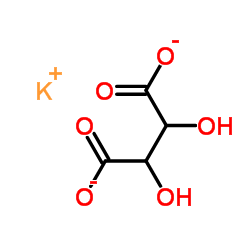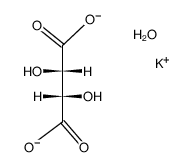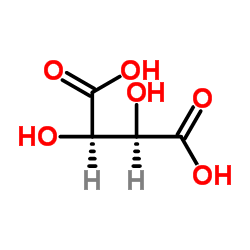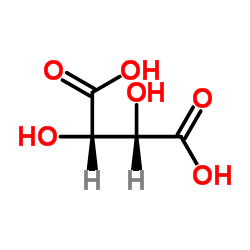526-94-3
| 中文名 | 酒石酸氢钠(一水) |
|---|---|
| 英文名 | Sodium Bitartrate |
| 中文别名 |
酒石酸氢钠,一水
酒石酸氢钠,一水 重酒石酸钠 酒石酸氢钠 酒石酸氢钠,单水合物 L-酒石酸氢钠 酒石酸氢钠单水合物 |
| 英文别名 |
EINECS 208-400-9
Monosodium tartrate Sodium bitartrate MFCD00065393 Sodium hydrogen tartrate Sodium 3-carboxy-2,3-dihydroxypropanoate Butanedioic acid, 2,3-dihydroxy-, sodium salt (1:1) Sodium bitartrate monohydrate sodium,2,3,4-trihydroxy-4-oxobutanoate |
| 沸点 | 399.3ºC at 760mmHg |
|---|---|
| 熔点 | 253 °C (dec.)(lit.) |
| 分子式 | C4H5NaO6 |
| 分子量 | 172.069 |
| 闪点 | 209.4ºC |
| 精确质量 | 171.998383 |
| PSA | 117.89000 |
| 外观性状 | 白色结晶粉末 |
| 储存条件 | 1.储存于阴凉、干燥、通风良好的库房。 2.远离火种、热源。防止阳光直射。包装密封。 3.应与酸类、食用化学品分开存放,切忌混储。储区应备有合适的材料收容泄漏物。 |
| 稳定性 | 按规格使用和贮存,不会发生分解,避免与氧化物接触 |
| 水溶解性 | H2O: 0.1 M at 20 °C, clear, colorless |
| 计算化学 | 1.疏水参数计算参考值(XlogP):无 2.氢键供体数量:3 3.氢键受体数量:6 4.可旋转化学键数量:3 5.互变异构体数量:无 6.拓扑分子极性表面积118 7.重原子数量:11 8.表面电荷:0 9.复杂度:157 10.同位素原子数量:0 11.确定原子立构中心数量:0 12.不确定原子立构中心数量:2 13.确定化学键立构中心数量:0 14.不确定化学键立构中心数量:0 15.共价键单元数量:2 |
| 更多 | 1. 性状:无色结晶或白色结晶性粉末 2. 密度(g/ cm3,25/4℃):未确定 3. 相对蒸汽密度(g/cm3,空气=1):未确定 4. 熔点(ºC):253 5. 沸点(ºC,常压):未确定 6. 沸点(ºC,8kPa):未确定 7. 折射率:未确定 8. 闪点(ºC):未确定 9. 比旋光度(º):未确定 10. 自燃点或引燃温度(ºC):未确定 11. 蒸气压(kPa,25ºC):未确定 12. 饱和蒸气压(kPa,55.1ºC):未确定 13. 燃烧热(KJ/mol):未确定 14. 临界温度(ºC):未确定 15. 临界压力(KPa):未确定 16. 油水(辛醇/水)分配系数的对数值:未确定 17. 爆炸上限(%,V/V):未确定 18. 爆炸下限(%,V/V):未确定 19. 溶解性:溶于水,不溶于乙醇,水溶液呈碱性。 |
Synonym:Butanedioic acid, 2,3-dihydroxy- (2R,3R)-, monosodium salt, monohydrate; Sodium hydrogen tartrate monohydrate Section 2 - COMPOSITION, INFORMATION ON INGREDIENTS
Risk Phrases: None Listed. Section 3 - HAZARDS IDENTIFICATION EMERGENCY OVERVIEW
Not available. Potential Health Effects Eye: May cause eye irritation. Skin: May cause skin irritation. Ingestion: May cause irritation of the digestive tract. Inhalation: May cause respiratory tract irritation. Chronic: May cause kidney damage. Section 4 - FIRST AID MEASURES Eyes: In case of contact, immediately flush eyes with plenty of water for at least 15 minutes. Get medical aid. Skin: In case of contact, flush skin with plenty of water. Remove contaminated clothing and shoes. Get medical aid if irritation develops and persists. Wash clothing before reuse. Ingestion: If swallowed, do not induce vomiting unless directed to do so by medical personnel. Never give anything by mouth to an unconscious person. Get medical aid. Inhalation: If inhaled, remove to fresh air. If not breathing, give artificial respiration. If breathing is difficult, give oxygen. Get medical aid. Notes to Physician: Section 5 - FIRE FIGHTING MEASURES General Information: As in any fire, wear a self-contained breathing apparatus in pressure-demand, MSHA/NIOSH (approved or equivalent), and full protective gear. Dusts may be combustible when exposed to heat, flame, or oxidizing agents. Extinguishing Media: For small fires, use water spray, dry chemical, carbon dioxide or chemical foam. Section 6 - ACCIDENTAL RELEASE MEASURES General Information: Use proper personal protective equipment as indicated in Section 8. Spills/Leaks: Vacuum or sweep up material and place into a suitable disposal container. Avoid generating dusty conditions. Provide ventilation. Section 7 - HANDLING and STORAGE Handling: Wash thoroughly after handling. Use with adequate ventilation. Minimize dust generation and accumulation. Avoid contact with eyes, skin, and clothing. Keep container tightly closed. Avoid breathing dust. Storage: Store in a cool, dry, well-ventilated area away from incompatible substances. Section 8 - EXPOSURE CONTROLS, PERSONAL PROTECTION Engineering Controls: Facilities storing or utilizing this material should be equipped with an eyewash facility and a safety shower. Use adequate ventilation to keep airborne concentrations low. Exposure Limits CAS# 526-94-3: CAS# 6131-98-2: Personal Protective Equipment Eyes: Wear appropriate protective eyeglasses or chemical safety goggles as described by OSHA's eye and face protection regulations in 29 CFR 1910.133 or European Standard EN166. Skin: Wear appropriate gloves to prevent skin exposure. Clothing: Wear appropriate protective clothing to minimize contact with skin. Respirators: Follow the OSHA respirator regulations found in 29 CFR 1910.134 or European Standard EN 149. Use a NIOSH/MSHA or European Standard EN 149 approved respirator if exposure limits are exceeded or if irritation or other symptoms are experienced. Section 9 - PHYSICAL AND CHEMICAL PROPERTIES Physical State: Crystalline powder Color: white Odor: none reported pH: acidic in solution Vapor Pressure: Not applicable. Viscosity: Not applicable. Boiling Point: Not applicable. Freezing/Melting Point: Not available. Autoignition Temperature: Not available. Flash Point: Not applicable. Explosion Limits, lower: Not available. Explosion Limits, upper: Not available. Decomposition Temperature: 426 deg F Solubility in water: Soluble. Specific Gravity/Density: Not available. Molecular Formula: C4H6O6.Na.H2O Molecular Weight: 190.09 Section 10 - STABILITY AND REACTIVITY Chemical Stability: Stable under normal temperatures and pressures. Conditions to Avoid: High temperatures, dust generation. Incompatibilities with Other Materials: Strong oxidizing agents. Hazardous Decomposition Products: Carbon monoxide, carbon dioxide. Hazardous Polymerization: Has not been reported Section 11 - TOXICOLOGICAL INFORMATION RTECS#: CAS# 526-94-3: WW8225000 CAS# 6131-98-2 unlisted. LD50/LC50: CAS# 526-94-3: Oral, mouse: LD50 = 4360 mg/kg. CAS# 6131-98-2. Carcinogenicity: Sodium hydrogen tartrate, anhydrous - Not listed by ACGIH, IARC, or NTP. Sodium bitartrate monohydrate - Not listed by ACGIH, IARC, or NTP. Other: See actual entry in RTECS for complete information. Section 12 - ECOLOGICAL INFORMATION Section 13 - DISPOSAL CONSIDERATIONS Products which are considered hazardous for supply are classified as Special Waste and the disposal of such chemicals is covered by regulations which may vary according to location. Contact a specialist disposal company or the local waste regulator for advice. Empty containers must be decontaminated before returning for recycling. Section 14 - TRANSPORT INFORMATION IATA Not regulated as a hazardous material. IMO Not regulated as a hazardous material. RID/ADR Not regulated as a hazardous material. Section 15 - REGULATORY INFORMATION European/International Regulations European Labeling in Accordance with EC Directives Hazard Symbols: Not available. Risk Phrases: Safety Phrases: WGK (Water Danger/Protection) CAS# 526-94-3: 1 CAS# 6131-98-2: No information available. Canada CAS# 526-94-3 is listed on Canada's DSL List. CAS# 526-94-3 is not listed on Canada's Ingredient Disclosure List. CAS# 6131-98-2 is not listed on Canada's Ingredient Disclosure List. US FEDERAL TSCA CAS# 526-94-3 is listed on the TSCA inventory. CAS# 6131-98-2 is not on the TSCA Inventory because it is a hydrate. It is considered to be listed if the CAS number for the anhydrous form is on the inventory (40CFR720.3(u)(2)). SECTION 16 - ADDITIONAL INFORMATION N/A |
|
毒理学数据: 急性毒性:大鼠经皮下LDLo:3gm/kg,除致死剂量外无详细说明; 小鼠经口LC50:4360mg/kg,除致死剂量外无详细说明; 小鼠经皮下LCLo:1gm/kg,肾,输尿管,膀胱-间质性肾炎; 兔子经皮下LDLo:1gm/kg,除致死剂量外无详细说明; 兔子经静脉LDLo:200mg/kg,行为-惊厥或癫痫,对肾,输尿管,膀胱引起其他变化; 生态学数据: 该物质对环境可能有危害,对水体应给予特别注意。 CHEMICAL IDENTIFICATION
HEALTH HAZARD DATAACUTE TOXICITY DATA
|
| 个人防护装备 | Eyeshields;Gloves;type N95 (US);type P1 (EN143) respirator filter |
|---|---|
| 危害码 (欧洲) | Xn |
| 安全声明 (欧洲) | S22-S24/25 |
| 危险品运输编码 | NONH for all modes of transport |
| WGK德国 | 2 |
| RTECS号 | WW8225000 |
| 海关编码 | 2918199090 |
|
~% 
526-94-3 |
| 文献:Lowry; Morgan Journal of the American Chemical Society, 1924 , vol. 46, p. 2192 Full Text View citing articles Show Details Docters van Leeuwen, J. Z. phys. Ch., 1897 , vol. 23, p. 34 - 38 Full Text Show Details Gmelin Handbook: K: MVol.6, 2.18.2.4, page 1217 - 1218 |
|
~% 
526-94-3 |
| 文献:Gmelin Handbook: K: MVol.5, 1.8.3, page 963 - 965 |
|
~% 
526-94-3 |
| 文献:Gmelin Handbook: K: MVol.6, 2.16, page 1162 - 1164 |
| 海关编码 | 2918199090 |
|---|---|
| 中文概述 | HS: 2918199090. 其他含醇基但不含其他含氧基羧酸(包括其酸酐、酰卤化物、过氧化物和过氧酸及该税号的衍生物). 增值税率:17.0%. 退税率:9.0%. 监管条件:无. 最惠国关税:6.5%. 普通关税:30.0% |
| 申报要素 | 品名, 成分含量, 用途 |
| Summary | 2918199090 other carboxylic acids with alcohol function but without other oxygen function, their anhydrides, halides, peroxides, peroxyacids and their derivatives。Supervision conditions:None。VAT:17.0%。Tax rebate rate:9.0%。MFN tariff:6.5%。General tariff:30.0% |








